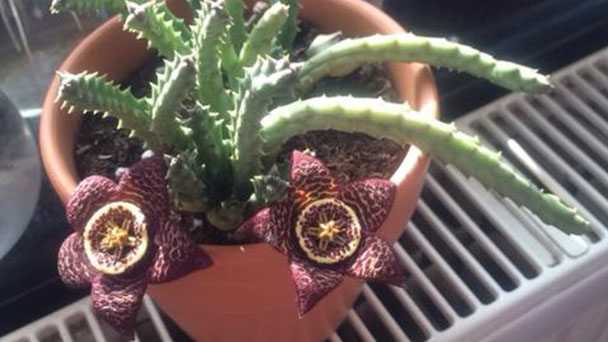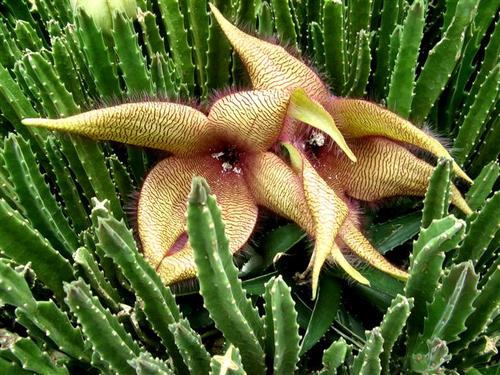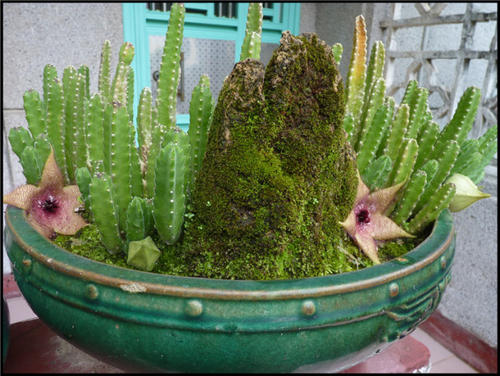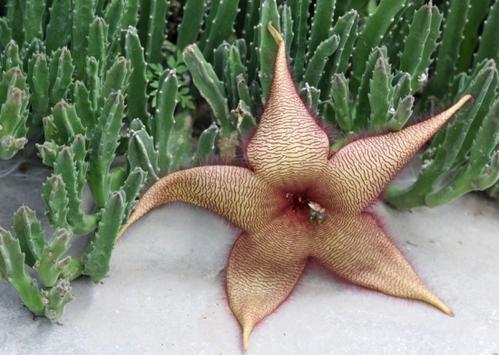Zulu giant profile
Written by Maggie
Mar 09 2021

Zulu giant, scientific name Stapelia gigantea, is a perennial succulent plant of an apelibate family, leopard skin flower. In the Banna Botanical Garden, Zulu giant grows a fleshy pulpy plant with a peculiar pattern of flowers. Bare fleshy stems are mistaken for cactus plants. But if you are lucky enough to see its flowers and fruit at the right time, you will know that it is the Zulu Giant (Stapelia grandiflora Curtis) of the Asclepidaceae family in the Euphrasiaceae family.
Zulu Giant picture

Zulu Giant morphological characteristics
Zulu Giant (Stapelia gigantea), a fleshy perennial herb, is 0.2-0.3 m tall. Stems are thick, angular, erect, 20-30 cm high, base branched, dentate, grayish green, rhinoceros horn - shaped. In autumn, it blooms flowering, big flowers, five crack open, starfish, very like, light yellow, with light black purple stripes, edge dense growth of fine hair, with a smell. Its descendants attract flies to pollinate the stench, so also known as smelly meat flower.Flowering from July to August.
Stems are 20 -- 30 cm tall, 3 -- 4 cm thick, hairy, much branched at base, tuft upward and erect, fleshy stem grey-green, four-horned, edges more flat, erect primary leaves, 0.2 -- 0.3 cm long, with serrated protrudes, light olive green.
Leaves are degenerate into pubescent acicular, longer than edges and dentate processes, 0.2 -- 0.3 cm long.
Zulu Giant (Stapelia gigantea) has 1-3 flowers growing from tender stems, large, 15 -- 25 cm in diameter, up to 30 cm occasionally; Stems are 5 cm long, thick, pubescent; Sepals are lanceolate, 0.8 -- 1 cm long, apex acuminate, hairy; The corolla is very large, common five petals, pentagonal star, six petals are relatively rare, in the bud was pentagonal ovate, apex acuminate; Central part is with a combination of shallow flattened disks;The back is furry; The inner surface has transverse fine folds, sparsely covered pilose, pale yellow with transverse scarlet stripes; Lobes are ovate-lanceolate, 10 -- 18 cm long, 5 -- 7 cm wide, apex acuminate, extended or antivolute; The outer accessory crack is elliptic, 0.5~0.6 cm long and 0.2 cm wide, with 3 serrated edges at the apex and dark purplish brown. Internal accessory lobes are oblong or nearly triangular-oblong, 0.4 -- 0.6 cm long and 0.2 -- 0.3 cm wide, abaxially winged, apex obtuse or acute, undivided, dark purplish brown; The inner Angle is 0.4~0.6 cm long, erect, chisel-shaped, blunt, almost upright; It gives off a stench like rotting meat and attracts flies to pollinate it. Flowering period is from July to August.
The fruit is follicles, slightly divided, 12.5~18 cm long, about 2 cm thick, nearly cylindrical, the apex is blunt and slightly hooked, hairy.
Origin and habitat of Zulu Giant
Zulu Giant (Stapelia gigantea) is native to Southern Africa (Northern Cape, Eastern Cape and Free State). It grows in the arid areas of tropical and subtropical South Africa. It has a strong habit and is suitable for sunny and warm and dry environments. It is resistant to early drying and semi-shade. The suitable temperature for growth is 16-22℃.

Growing management of Zulu Giant:
Zulu Giant (Stapelia gigantea) prefers dry soil and should avoid overwatering, even during the vigorous growth phase. Especially in the low temperature stage in winter and high temperature season in summer, the amount of watering should be reduced, because the growth rate of zulu giant is slow at this time, and the water absorption capacity of the root is poor. If the water is too much, the root rot is likely to occur. In addition to applying an appropriate amount of horseshoe pieces as base fertilizer at the bottom of the flowerpot when planting, thin liquid fertilizer should be applied every half a month in spring and autumn during the vigorous growth stage of the plant. Zulu Giant likes a sparse shade environment, but in winter, when the temperature is low, adequate sunlight should be ensured, otherwise it will adversely affect plant growth. It likes warm, avoids high temperatures, not cold, in the temperature range of 18-22℃ growth well, and overwintering temperatures should not be less than 8℃. In practical cultivation, Zulu Giant may be harmed by stem rot, which is mainly caused by excessive watering during high temperature in summer or low temperature in winter. Before planting, the disease can be basically avoided as long as the soil is properly disinfected and watering is properly controlled to keep the pot soil in a state of constant wet and dry. The Zulu Giant is invaded by pests such as the whitefly. Since it does not grow very fast, large plants that are more than two years old should be turned over every two years in April, and some of the fleshy stems that are too old should be cut off.
Zulu Giant propagation methods
Zulu Giant (Stapelia gigantea) is propagated by dividing, cutting or sowing. Division is usually carried out in early spring with the combination and changing of pots. Cuttings can be made at any time. Seedlings grow slowly and need 4 to 5 years to flower. Adequate fertilizer and water are required during the growing period. Top dressing, chicken manure or compound chemical fertilizer can be applied every 15 to 20 days. Zulu Giant likes warm, the cold resistance is slightly poor, the suitable temperature for growth is 18~25 ℃. Sunshine must be sufficient, but under the scorching sun, there should be a little shade. Zulu Giant has strong drought tolerance, but long drought, the stem will be dry shrinkage is not full, the best medium for cultivation is good drainage sandy loam. In summer shading requirements are of 50% shading, usually requirements basin soil see dry see wet, do not water, so as not to rot root.
Zulu Giant main usage
Zulu Giant (Stapelia gigantea) is a beautiful indoor ornamental flower with tall fleshy stems, rhinoceros horns and strange flowers like starfish. It is often planted as a potted plant for the enjoyment of exotic flowers, or as an outdoor plant between rocks. Zulu Giant can be used for makeup, study, living room desk, coffee table.

Latest Updated
- Benefits of Bugleweed - 7 Science-backed Health Benefits
- Bugleweed Dangers & Side Effects - Is It Poisonous?
- How to Plant Evergreen Trees - What You Should Know
- When to Plant Evergreens - Grow Guide for Evergreen Trees
- 12 Wonderful Evergreen Shrubs for Your Garden
- 12 Popular Evergreen Plants with Pictures for Beginners
- When And How To Prune A Lilac Bush Like a Pro
- How to Grow & Care for Lilac Vine (Hardenbergia Violacea)
- Japanese Lilac Tree (Syringa Reticulata) Care & Propagation Guide
- Shumard Oak Pros and Cons - What to Know
Popular Articles
- Winter maintenance of Antirrhinum Majus
- How to Grow Terminalia Mantaly Tree
- How to Grow and Care for Crossostephium Chinense
- How to grow Antirrhinum Majus in spring
- Peristeria Elata (Dove Orchid) Profile: Info & Care Guide
- Underwatered Snake Plant (Sansevieria Trifasciata) - Signs And How To Fix
- How to Care for Brazilian Jasmine Plant (Mandevilla Sanderi)
- How to Grow & Care for Graptopetalum Purple Delight in Summer
- Rosa Chinensis (China Rose): Plant Growing & Care Tips
- How to Care for Baby Sun Rose (Aptenia Cordifolia)